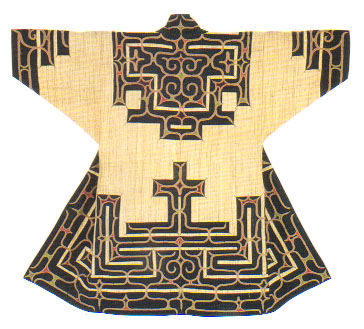アイヌ文化Ainu Culture

Design by Sanae Ogawa, Machiko Kato / Courtesy of Shibunkaku Co., Ltd.
Though relatively young compared with the rest of Japan, Hokkaido still has a rich and fascinating history. This is in part due to the fact that this is where a great many Ainu people have日本の中では比較的歴史が浅いといわれる北海道にも、豊かで素晴らしい歴史が存在する。それは多くのアイヌの人々がこの地を「アイヌモシリ」と呼ぶことに理由がある。アイヌモシリとは、「アイヌの地、静かで平和な人間の地」を意味する。
![]()
アイヌ民族と日本人は、平和的にしろ、時にはそうでない形にしろ相互関係があった。そのコミュニケーションは時を経るごとに崩壊し、遺憾ながら多くの先住民族がそうであるように、アイヌも人種差別と戦うことになる。このことが、アイヌが再び権利を取り戻すまでの抗議運動やデモ活動に繋がり、そうした活動の中心が北海道、特に札幌にある。アイヌ文化を知ろうとする者にとって見逃せない、豊富な情報を得て体験することができる場所だ。
![]()
アイヌ文化の理解を深めたい方に、まず2つの機関を紹介したい。
![]()
ひとつは、アイヌ文化の研究調査を行い、その成果の普及を目的として開設された、札幌の中心街にある「北海道立アイヌ民族文化研究センター」。研究センターはここで、様々な角度からアイヌ文化の理解を広め、研究成果を公開している。ここには多くの資料があり、スタッフが親切に対応してくれる。
![]()
そこから道を一本隔てた「かでる2・7」には、北海道アイヌ協会が運営する「北海道アイヌセンター」がある。ここには様々な道具や地図、写真、映像などが常設展示されている。また、アイヌ文化の体験学習のために設置された保存実習室では、刺繍の実践、アイヌ語や各種儀式、古式舞踊の学習ができる。
![]()
他にも札幌市近郊には多くの展示施設がある。
![]()
厚別の野幌森林公園にある「北海道開拓記念館」。ここでは北海道の歴史を幅広く紹介しており、アイヌ文化を扱う展示は少ないのだが、見ておきたい場所である。アイヌの家の複製をはじめ、多くの展示物がある。一般的なアイヌ文化や歴史を学びたい人におすすめの場所だ。
![]()
札幌以外には、網走の「北海道立北方民族博物館」、静内町「アイヌ民俗資料館」、平取町「二風谷アイヌ文化博物館」などでも展示物を見ることができる。
![]()
それから、南区の小金湯温泉の渓谷に位置する「札幌市アイヌ文化交流センター・サッポロピリカコタン」。外にはアイヌのコタン(村)が再現され生活様式を体験、撮影することもできる。またセンター内には、受付、会議室、講義室、休憩場所、廊下展示スペース、体験ホール、情報コーナーなどがある。入場料を払って入る展示室には、見て触れることのできる展示物が多く揃っている。展示物にはバーコードがついており、スキャンすることによってコンピューターでさらなる情報を見る事もできる。
その他のコタンには、昔のアイヌの生活を再現した白老のテーマパーク「アイヌ民族博物館・ポロトコタン」、現代アイヌが生活する「阿寒湖アイヌコタン」などがある。
![]()
アイヌのアーティスティックな側面を知りたい方には、信仰深い作品を制作するアイヌの彫刻家、砂澤ビッキを紹介したい。ビッキは、日本とアイヌのアートを融合した現代彫刻家だ。彼の作品を専門に扱う展示施設が、北海道の北端、音威子府村にある。音威子府は彼がアトリエを構え晩年生活を営んでいた場所で、「エコミュージアムおさしまセンター BIKKYアトリエ3モア」というその施設には約150の作品が収蔵されている。独自のビジョンを持つ砂澤ビッキの作品は、抽象的な『動物』のシリーズから『樹華』のシリーズまで、どれもとても繊細かつ大胆で独創的。万人に訪れて欲しい施設だ。
また、ビッキの代表作の1つ『四つの風』(1986) は、「札幌芸術の森野外美術館」で見ることができる。
![]()
北海道の歴史において欠くことのできないアイヌ文化。アイヌ文化を学ぶ上で、北海道は重要な存在である。この共生の関係は、理解を高めるための素晴らしい機会や、真正さや豊かさ、影響のある文化に対する敬意を生み出している。このような機会を見逃さないで欲しい。
![]()
Text: Jacqueline Ste-Croix
Translation: Yurie Hatano, and continue to, called Ainu-Mosir. It mean “a peaceful land of humans”.
![]()
There was interaction between the Ainu and the Japanese, some peaceful, some less so. Communication eventually broke down and the Ainu, like most indigenous people unfortunately, became the victims of racial discrimination. This lead to protests and demonstrations until the Ainu obtained their rights once again. Hokkaido, Sapporo specifically, seemed to be at the center of the movement. As such, for someone interested in Ainu Culture, this is the place to be, as there is a wealth of information and experiences to be found.
![]()
For those that like to do their own research, there are two great organizations at their disposal. First there’s the Hokkaido Ainu Culture Research Center, on the fifth floor of the Presto building in downtown Sapporo. In an attempt to give Ainu Culture a broader exposure, the Hokkaido Ainu Culture Research Center was established. There is a small reading corner with many materials for public use and a friendly staff ready to help.
![]()
Just across the street is the Kaderu building where, on the seventh floor, one can find the Hokkaido Ainu Center, run by the Ainu Association of Hokkaido, an incorporated organization of Ainu people whose goal is to preserve and promote their culture. The Hokkaido Ainu Center maintains a constant exhibit featuring many authentic Ainu items, maps, photos and videos. Across from this is the Practical Preservation Training Room with an authentic Ainu fireplace.
![]()
If you prefer to learn by experiencing and seeing things first hand, there are a great many exhibits in and around Sapporo.
![]()
First, there’s the Historical Museum of Hokkaido in Nopporo Forest Park, in Atsubetsu. It covers the entire history of Hokkaido, as such only a relatively small section is designated for Ainu Culture, however, this should not deter people from visiting. There are many items on display including a replica of an Ainu house. Anyone interested in Ainu Culture and history in general would enjoy the Historical Museum of Hokkaido. For a similar experience there is also the Museum of Northern Peoples in Abashiri, the Shizunai Ainu Museum, and the Nibutani Ainu Culture Museum.
![]()
And there’s the Sapporo Ainu Culture Promotion Center, Pirka Kotan in the valley of the Koganeyu Onsen. Outside there is an Ainu village which you can explore. In the Promotion Center guests will find the Information Desk, Conference Room, and Lecture Room. Downstairs there is the Rest Corner, Street Gallery, Interaction Hall, Information Corner. Finally there is the Exhibition Room, though there is a small fee to enter here. It is worth it however, as there are many authentic items to see and touch most with a barcode that can be scanned into a computer to learn more about it. There is so much to see and do, you’re guaranteed an enjoyable experience.
To see more Kotans, you can go to the Ainu Museum, Poroto Kotan where old Ainu life is recreated in Shiraoi, and the Ainu Kotan, the authentic Kotan that current Ainu people are living, in Akan.
![]()
For those of the artistic persuasion, there is an Ainu sculptor whose works must be seen to be believed. His name is Bikky Sunazawa and he was one of the first contemporary artists to integrate Japanese and Ainu art. There is a museum dedicated to his works in the village of Otoineppu near the Northern tip of Hokkaido; one of the places he once called home. This is the Eco Museum Osashima Center BIKKY Atelier 3moa, and it holds around 150 of his works. A man of exceptional vision, his works are truly inspiring, from his abstract “Animals” series to his “Juka” series, there is likely something for everyone here.
One of his masterpieces “Four Winds” (1986) can be found at Sapporo Sculpture Garden in Sapporo Artpark.
![]()
Its obvious that the Ainu are an integral part of Hokkaido’s history, while Hokkaido is an important asset to the study of Ainu Culture. This symbiotic relationship has given rise to great opportunities for one to enhance one’s understanding of, and appreciation for, such an authentic, rich, and influential culture. Such opportunities should not be missed.
![]()
Text: Jacqueline Ste-Croix
